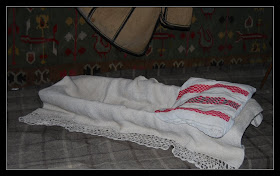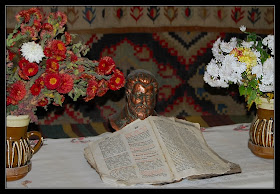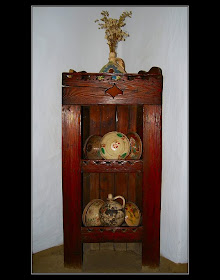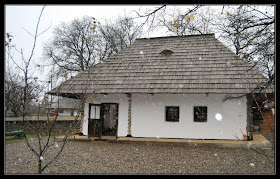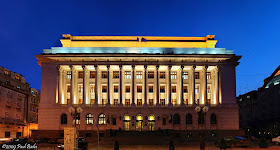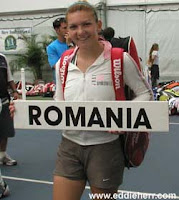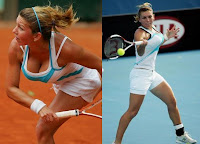 The Creation of the World
The Creation of the WorldThe creation of the world in Romanian folklore is most probably based on mazdeist doctrines, which entered the mythologies of many peoples including the Daci, the ancestors of the Romanian people, and which were left behind by these. As such, far from coinciding with the story in the Book of Genesis, cosmogony is largely dualist in nature, depicting the Earth as the common opus of God and the Devil, imagined as counterparts of Ahura Mazda and Angra Mainyu rather than in the biblical way. However, different stories suggest God made the earth with the help of animals, while Satan was trying to thwart his plans.
In the majority of versions, before the earth existed, a boundless ocean called Apa Sâmbetei was the abode of God and the Devil, seen as master and servant rather than equals. Upon deciding to create the earth, God sent the Devil to bring a handful of clay from the ground of the World Ocean in his holy name. The Devil set forth and tried to bring it to the surface in his name instead, but could not succeed until he brought it up in the name of God. As this piece of clay grew into the earth, God laid himself down to sleep. The Devil tried to push him over the side, but the ever expanding earth would hinder that. After trying to throw God off the earth in every one of the four cardinal directions, he shied away from the cross he drew in the ground himself.
The Origin of EvilOther accounts, closer to the biblical one, suggest that the Devil and his demons were once angels of God. The Devil, however, tried to rebel, and, in response, God opened up the Heavens so that he might fall to the earth. Fearing that Heaven might be voided, the archangel Michael re-sealed it, thus freezing the demons that had not yet fallen to hell in place. This is related to the concept of soul customs, where every soul is intercepted on its way to Heaven by these demons, who force it into hell. It has also given rise to the Romanian saying până ajungi la Dumnezeu, te mănâncă sfinţii (before you reach God, the saints will eat you).
The Origin of GodAnother question commonly addressed is that of the origin of God, which is explained in a Russian doll type fashion. Before every God there was another God that created him. Thus explaining the many names the Bible used for God, the Oltenians believed the first God was called Sabaoth, followed by Amon, Apollo, the Creator God of the Bible, and finally, Jesus Christ.
The Origin of RaceQuite surprisingly for a Caucasian race, Romanian folklore asserts that, as God had made the humans out of clay, and clay was perceived to be black like soil, the first humans were black-skinned. It was later during the time of Cain and Abel that God did punish the murderous Cain by bleaching his skin. This is identified as the source of the expression a se îngălbeni de frică (to go yellow with fear), which can also be found in various forms in the folklore of other peoples.
Although, some sources attest that the Dacians were already familiar with dark-skinned people as evidence of the existence of an African race appears to have been found on the territory of Romania:
A new people has been discovered in prehistoric Dacia, this time of ethiopian race and of a blackish-yellow or tan colour. Its stay there has left deep marks in our ethnic, heraldic and geographical nomenclature as to how prehistoric Dacia was first called Ethiopia, then Arabia, and through a longer process, Bessarabia.
– Ionescu, G.M., Etiopienii în Dacia Preistorică / The Ethiopians in Prehistoric Dacia, 1926, Bucharest: Tipografia de Carti LUCIA, p 3.
The EarthAs in other cultures, the Earth was regarded as a giver of life even before Christianity had spread to the Romanian lands, and as such, was personified as the feminine archetype of the Great Mother. This form can be traced back to the Iranian mazdeist religion, where Spenta Armaiti is found as the personification of the Earth. This form endured even after Christian imagery and symbolism became part of Romanian culture, Mother Earth often being identified as the consort of God, the heavenly Father.
The origin of mountains is explained in a number of ways by the cultures of the different regions of Romania. One account is that mountains formed as a response to God demanding the Earth to nurture all life, to which the earth shuddered and brought forth mountains. Another version suggests the Earth was too large to fit under the firmament, and so God attempted to shrink it, thus raising mountains. Often, these accounts are accompanied by the imagery of one or several World Pillars, which sustain the earth from below and are usually placed beneath mountains. Earthquakes are frequently attributed to the earth slipping due to the Devil's constant gnawing at these pillars, which are rebuilt by God and his angels in times of fasting.
The Myth Of The BlajiniAs Romanians generally perceived the earth as a disc, they were naturally creative enough to imagine what existed on the other side. This other earth is imagined as a mirror image of our own, and as a home to creatures called Blajini [bla'ʒinʲ] (rom. gentle/kind-hearted ones), sometimes given the name Rohmani ['roh.manʲ] (in Bucovina. They are described as anthropomorphic and short, sometimes having the head of a rat. They are either described as malicious or as having great respect for God and leading a sinless life. They are considered to fast the year through, and thus doing humans a great service.
The Romanian holiday Paştele Blajinilor (the Easter of the Blajini) is a way to repay them for the benefits they bring. Since they live in isolation, they have no way of knowing when Easter comes. It is for this reason that Romanians eat dyed eggs and let the shells flow downstream, from there they believe they will get to the Apa Sâmbetei, and from there to the Blajini.
Some explain them as the descendants of Adam's son Seth. Others state that they used to live alongside humans on the earth, but that Moses, seeing his people oppressed by them, parted the waters and, after he and his people had retreated to safety, poured the waters back onto them, sending them to their current abode.
